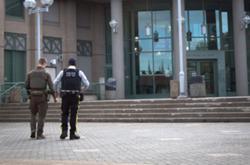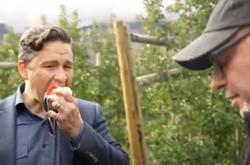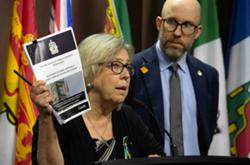“You’ve probably seen the building,” Kirsty Gordon says. “That big, gigantic blue box?”
Gordon is referring to the Elizabeth Fry Society’s transition house. She heads up the Woolwerx Fibre Arts Studio, a project of the Elizabeth Fry Society, which employs about a half-dozen marginalized women at a time.
The women work part time in a converted residential building nearby the transition house, using local wool to create hand-felted dryer balls, hand-spun yarn and, at Christmastime, adorable sheep-themed ornaments.
The work is transformative, Gordon says. The routine offers structure, but enough flexibility that women can go to school and attend to other life matters. Just as importantly, the repetitive nature of felting and yarn spinning is meditative and therapeutic. “It allows women to get out of their trauma, and the issues that they deal with,” Gordon says.
“I love working with my hands. That’s pretty much how I learn the best, if I’m actually doing it,” says Amanda Bastian, a Woolwerx employee. “I’ll probably go into something else after this where I’m also working with my hands. Maybe carpentry.”
“They’re transferable skills,” Gordon adds. “You’re learning how to work to a process, create a routine and go step by step.”

Woolwerx is also a no-waste operation — using “waste wool” donated from farmers and left over from their other projects, they’ve been creating pelletized fertilizer. So far, Gordon estimates they’ve diverted about 60 fleeces from the landfill, producing about 1,800 bags of pelletized wool fertilizer.
Traditionally, waste wool has consisted of fleeces or partial fleeces that are too dirty to be carded and used for primary products, such as yarn or wool batts. Today, it also includes a veritable mountain of Canadian wool that farmers, who nowadays most often raise sheep for meat, are no longer being paid enough to take to market.
Though wool is high in nitrogen, unprocessed fleeces don’t immediately make great fertilizer if left to their own devices. They take a long time to break down, and they tend to hold water and clump up when they’re buried or left on top of soil.
Pelletizing the fleeces provides a solution: using a machine, companies such as Woolwerx process that clumpy, stubborn wool into shorter, broken-up strands of material, which then gets treated under high heat and pressure. The machine spits out short pellets, around the size of rabbit feed, that can be tilled into soil, added to compost piles or used as top dressing to help retain soil moisture. The high heat and pressure used to create the pellets guard against incidental spread of pathogens and weed seeds.
These days, most waste wool in Canada ends up being taken to the landfill or burned by farmers. Processing the fleeces and turning them into fertilizer pellets means their nitrogen enters the circular economy instead of going to waste — or adding to the country’s emissions on a burn pile.

Waste not wool
Leanna Maksymiuk raises a small flock of a specialty breed of sheep called Navajo-Churros on her farm outside Lumby, B.C., in the province’s Thompson Okanagan region. She also has a few jet-black sheep — Shetland-Jacob crosses, she says. This wool is in demand with hand-spinners, makers and weavers; the first time Maksymiuk sheared her flock, she sold out quickly.
“I thought, what am I going to do? Because I wasn’t going to shear again for six months, and I was starting to grow a customer base for the wool,” she says.
Her mind turned to farmers who raise sheep for meat — and who have to shear their sheep to keep them healthy.
Globally, the market for wool is focused on breeds like merino, whose eponymous wool is soft and pleasant to wear close to the skin. Sheep raised for meat in Canada tend to be chosen for different qualities — their hardiness, for example — and have tougher, scratchier, more durable wool that’s better for items like rugs or pillow covers. As cheaper synthetics have entered the market for home textiles, the prices for wool have dipped too low to justify farmers transporting the wool for sale.
“I reached out to a couple of farmers I knew, and I said, you know, ‘What do you do with your fleeces?’ They told me they took them to the dump,” Maksymiuk says.
Tamara and Hans Krul of 3 Willows Homestead in Armstrong, B.C., have a flock of about 25 mostly North Country Cheviot sheep they raise for meat.
Initially, the Kruls, who shear their sheep themselves, thought they might be able to sell the wool. But instead, it went to waste — the fibre is not good for wool, Tamara says.
So they contacted Maksymiuk and donated their wool to her.

Before Maksymiuk knew it, she had more fleeces than she knew what to do with. It was time-consuming to pick through the wool, she says, and even after picking through, she was left with a mountain of waste wool that was too dirty to process into something usable for spinners and weavers.
Maksymiuk had heard of pelletized wool fertilizer, and it seemed like a workable option. With the help of the Reach program, which provides mentorship and a small grant to help develop agricultural businesses, she purchased a pellet mill from a company in the Czech Republic called Elf.
“The investment at the time was about $34,000,” Maksymiuk says. “That’s a huge investment for us. My husband and I both work off-farm. But we just kind of jumped in and did it.”
It took some work to dial in the machinery, but a few years later, Maksymiuk estimates her company, Waste Not Wool, has diverted about 9,000 pounds of wool from the landfill.
The resulting pellets, which sell for $35 for a two-kilogram bag on Waste Not Wool’s website, can be used in several ways. You can till them into the soil or use them as mulch in beds, pots or baskets, Maksymiuk says. You could also add them to your compost to break down if you use a top-dressing, no-dig method.


Woolwerx sells its pellets in person and at its storefront in New Westminster, and also supplies them to West Coast Seeds, where they sell for $14.99 for 270 grams.
A single 270-gram bag is enough to amend 15 litres of soil.
The pellets have the added benefit, Maksymiuk says, of helping keep the soil moist — a help as B.C. adapts to dealing with increasing drought.
Opportunities to scale up
Maksymiuk collects wool from in and around the Okanagan — Kamloops, Kelowna, Armstrong. Three retailers in the Okanagan sell Waste Not Wool’s pellets, and she also sells them at farmers markets.
So far, the market consists of home gardeners — but Maksymiuk says that if some larger operators with larger mills entered the field, wool-based fertilizer could become a more efficient soil amendment option for farmers. The research is preliminary but promising — the pellets performed similarly to commercial fertilizer in a few initial organic vegetable trials.
Maksymiuk’s machinery allows her to process somewhere in the neighbourhood of 65 to 67 pounds of wool an hour. It’s not nearly enough to keep up with supply, she says.
“I had to put a thing on my answering machine that was like, ‘If you’re calling for me to come get your wool, unfortunately, I can’t take any right now,’” Maksymiuk says.
In other words: there’s a lot of waste wool to be had.
Woolwerx received a grant to purchase its machinery; the business is a social enterprise, Gordon says. The goal is to pay a living wage without the pressure of having the business break even.
For Maksymiuk, her wool pellet business isn’t profitable — yet. The family is still paying off their initial machinery cost.
“The hope is that we can sell enough pellets that we will have enough revenue that we can pay farmers. That’s the big goal,” she says.
But for now, farmers donating wool is a great stopgap measure — they don’t like to see it go to waste.
“A lot goes into it, right,” Maksymiuk says of raising sheep. “The sheep get fed before I feed myself every day. The first thing I do is go tend to the sheep and make sure everybody’s OK and no one had any problems overnight. You feed them, make sure they have water. And then I do it all again at bedtime. I call everybody in and they come to my voice and I talk them in. You’re connected to them. I think that you have to be, to be a farmer. You have to really appreciate the animals that you’re caring for.”
“For me, if I was throwing out the wool — it would hurt my feelings,” she adds.
“I think it’s great,” Tamara Krul says of Maksymiuk and Waste Not Wool. “It’s exciting to see her do what she’s doing with the wool.” ![]()
Read more: Local Economy, Environment

















Tyee Commenting Guidelines
Comments that violate guidelines risk being deleted, and violations may result in a temporary or permanent user ban. Maintain the spirit of good conversation to stay in the discussion and be patient with moderators. Comments are reviewed regularly but not in real time.
Do:
Do not: